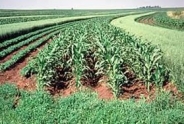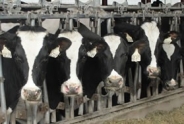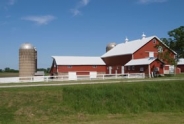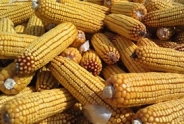Cornell Deer Worm Fact Sheet
Deerworm Fact Sheet for Sheep and Goat Producers
Courtesy of Cornell Sheep & Goat Program and Cornell Ambulatory Veterinary Services. Modified by Amy Barkley for length.
Funding provided by the Beakman Fund and the Hatch & Smith-Lever Federal Capacity Fund Grant "Application of New Concepts for Control of Internal Parasites in Sheep and Goats".
What is Deer Worm?
Deer worm, aka meningeal worm, (Parelaphostrongylus tenuis (abbreviated P. tenuis)) is a parasitic worm of ruminants. It is very common in white-tailed deer in the Northeast United States (up to 90% of deer harvested during hunting season have been shown to be infected) but does not cause disease in this species. The worm has an indirect life cycle, requiring land snails or slugs as intermediate hosts before being able to infect a sheep or goat from the consumption of slugs/snails and their slime from pastures shared with deer. Sheep and goats are not the ideal host, so this parasite ends up causing serious neurologic disease as it attempts to grow and reproduce in these species.
What are the Signs of Deer Worm Infection?
There are two common types of signs that an infected sheep or goat may show. Many affected animals will have trouble moving around; early signs of deer worm infection include mild stumbling, knuckling and/or dragging the toes of one or both hind limbs, and general weakness of the hind limbs. In more advanced cases the sheep/goat may suffer total paralysis of the hind limbs, leaving it sitting in a dog-sitting posture or down and unable to get up. The front limbs are less commonly affected but can have the same problems as the hind limbs. Even in a case of total limb paralysis, animals may still recover fully given proper treatment and/or time.
Another common sign associated with deer worm infection is excessive itching and rubbing of one area on the side of the body. Migrating larvae can irritate an individual nerve where it merges with the spinal cord, making the animal rub and/or bite incessantly at the area where the nerve runs. This leads to hair loss and occasionally a wound in the skin. Less commonly, infected animals will show signs of brain disease such as a head tilt, walking in circles, rapid eye flickering, and difficulty chewing. Appetite and body temperature typically remain normal in animals affected with the deer worm, which is not often the case with other common diseases of the brain in sheep and goats. It is important to note that not all affected animals will show all these signs. There can be a wide range of manifestations of deer worm infection, so it is important to be vigilant in watching for any problems with your animals.
The diagnosis relies heavily on gazing history combined with symptoms. If you would like to confirm the diagnosis, your vet can submit a sample of brain and spinal fluid to confirm the characteristic microscopic signs of infection.
Cornell's Deer Worm Research Shows a Promising Treatment
A four-year study by the Cornell Sheep & Goat Program and Cornell Ambulatory Veterinary Services investigated the effectiveness of two different treatment protocols for naturally infected sheep and goats. Participating goat and sheep farmers knowledgeable about deer worm contacted the researchers when they observed a suspected case of deer worm infection to determine if the animal qualified for enrollment in the study. Enrolled animals were randomly assigned within herd to a treatment or control group with treatments alternating for succeeding animals from the same farm. The treatment group received 5 days of oral fenbendazole (25 mg/kg), intramuscular dexamethasone (0.2 mg/kg for 3 days followed by 0.1 mg/kg for 2 days) and subcutaneous ivermectin (0.5 mg/kg); the control group received the same 5 day course of fenbendazole and dexamethasone with a similar volume of placebo vehicle subcutaneously. Farmers and study veterinarians were blinded to treatment. Neurologic examinations were conducted on all animals. Animals received a neurological score at the time of enrollment and after treatment that ranged from 1 (unable to stand) to 5 (no detectable neurologic deficits or only an expert would notice), with a score of 4 indicating likely to function in the herd for breeding though noticeably impaired.
Twenty goats and 18 sheep from 10 central NY farms were enrolled in the trial with 9 goats and 9 sheep in the control group and 11 goats and 9 sheep in the treatment group. Animals were classified as recovered if they required no further treatment to potentially remain in the breeding herd after the 5-day treatment period. Six of 9 sheep treated with ivermectin recovered without further treatment but 3 had to be euthanized. Five of 9 sheep treated with the placebo recovered without further treatment; 2 required additional treatment, and 2 had to be euthanized. All 11 of the goats treated with the ivermectin recovered, while six of the nine treated with the placebo recovered without further treatment, and 3 required additional treatment.
Statistical analysis indicated that higher pretreatment neurological scores improved outcome. That is, the less severe the symptoms were before treatment started, the better the chance of recovery. The effect of adding in ivermectin to the treatment protocol showed promise, though not statistically significant. However, all 11 goats treated with ivermectin were categorized as recovered. The better outcomes for goats are probably explained by closer observation of goats (coincidentally all goats were returned to barns at night while all sheep were left in pastures 24/7) which resulted in better pre-treatment neurological scores. Given the importance of pre-treatment score on the odds of recovery, close observation of animals at high risk for P. tenuis infestation is warranted for timely treatment. Studies with larger numbers of animals are needed to definitively state whether including ivermectin in the treatment protocol improves outcome. Inclusion of ivermectin increases the drug withdrawal period for the standard protocol to 96 days or more according to FARAD, the Food Animal Residue Avoidance Databank. If there is no concern about the withdrawal period, we cannot rule out the possib+ility that ivermectin may be beneficial in the treatment of highly valuable animals.
Can Infection be Prevented?
Regular deworming to prevent deer worm is expensive and time consuming, and results in faster dewormer resistance to the other worms of economic importance to sheep and goat producers. Reducing exposure is the most reasonable preventative. Pastures bordering woodlands and low-lying/wet areas are the highest risk of both deer exposure and snail/slug habitat. If these areas need to be part of a regular pasture rotation, consider not grazing them during the wet season or after tree leaves have fallen. Having a livestock guardian regularly patrolling pastures can limit deer visits as well.
While deer worm used to be a disease limited to the eastern side of the state, we are seeing an increased incidence of cases in WNY. Prevention, vigilance, and treatment for this parasite are now necessary. If you are in SWNY and have questions about parasites, feel free to reach out to Amy Barkley at 716-640-0844 or amb544@cornell.edu.
The original article can be found at https://blogs.cornell.edu/smal...
Upcoming Events
NY Small Farms Summit 2025: Stronger Together
December 5, 2025
Alfred, NY
We hope you will join us on December 5th for the 2025 New York Small Farms Summit! This is an opportunity to meet other farmers and ag supporters, learn about research and education projects, and set priorities for future efforts to grow small farm success.
At the Allegany County site, we will focus on giving trees a chance and how trees build resiliency on small farms. Whether attracted to fruit, nuts, vegetables, fodder or shade, trees can be an integral part of a successful farming system. Join us as we explore the opportunities for resiliency that come from adding tree crops or managing wooded areas of your farm for agroforestry or silvopasture systems.
Crops, Cows & Critters - Southwest New York Dairy, Livestock & Field Crops Newsletter Sponsorship
December 19, 2025
Our two forms of publications feature research-based and timely information from our four specialists, listed to the right, along with local event notifications and Cornell University outreach. This information is provided to participants who range from dairy, livestock, and field crops producers to agricultural suppliers and consultants.
Weekly Email Update: Shared with 625+ households who have signed up with our program.
Monthly Paper Mailer: To reach our stakeholders and farmers who lack internet access, we send out a monthly mailer where your company's logo and contact information would be featured with a mailing list of 330+ households.
If you sponsor our weekly and monthly publications you reach approximately 955 households.
Visit our website to view our newsletters!
2025 Cornell Food Beverage & Animal Feed Manufacturer Survey
December 19, 2025
Industry and Educational Advocates for New York State's Food, Beverage, and Animal Feed Manufacturing industries:
As you know, NYS has a diverse food and beverage manufacturing industry, in both the types of industries that exist and the wide distribution of firms by scale. Many manufacturing firms have strong backward linkages to agricultural production sectors in the state that support both farm-level and downstream food industry firms and consumers. In collaboration with the New York State Department of Agriculture and Markets, a team from Cornell University's Charles H. Dyson School of Applied Economics and Management has recently rolled out the 2025 New York State Food, Beverage, and Animal Feed Manufacturer Survey. The industry will benefit from an updated assessment of the industry that informs private and public investments and opportunities to support firm growth and improved profitability.
Announcements
No announcements at this time.





